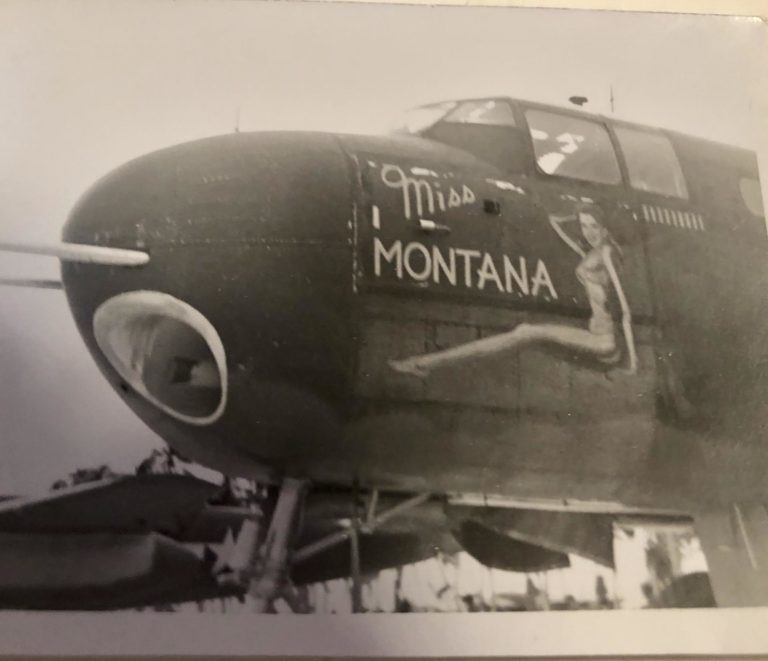After a year of restoration by dozens of volunteers at the Museum of Mountain Flying, “Miss Montana,” a Douglas C-47 built in 1944 s reached Duxford, England on May 28, 2019. Scheduled to participate in “Daks over Normandy” the restored plane will drop paratroopers over France on June 5, 2019. Although currently known as “Miss Montana,” the plane was originally known by its number N24320, and is also known as the Mann Gulch plane.

Piloted by Jeff Whitesell, “Miss Montana” left Missoula on May 19, 2019 with six aboard, bound for England along the Blue Spruce Route through Newfoundland, Greenland, Iceland, and Scotland.
Manufactured in 1944, just before the D-Day invasion, N24320 did not participate in World War II, although it did have a long and storied career. The Johnson Flying Service of Missoula, Montana bought the plane and used it to support US Forest Service personnel in Western Montana and Northern Idaho. Responding to a wildfire near Helena, Montana in August 1949, N24320 dropped 15 smokejumpers over Mann Gulch. The fire blew up and 12 of the smokejumpers, as well as a Forest Service smokechaser, were killed, the worst tragedy for smokejumpers up to that time. Five years later the plane crashed into Pennsylvania’s Monongahela River in December 1954, killing the pilot and nine others. The plane was recovered and put back in service the following year by Johnson Flying Service.
N24320 was eventually sold to McNeely Charter Service in Arkansas, but by 2001 McNeely was looking to sell the plane. Dick Komberec, a founder of the Museum of Mountain Flying in Missoula learned the plane was for sale in 2001, and $125,000 was raised to purchase the plane and return it to Missoula, where it became the centerpiece of the museum.
In early 2018 Eric Komberec (Dick’s son) and Bryan Douglass learned of the Daks over Dakota project to fly vintage C-47s over the D-day invasion area for the 75th anniversary of the Normandy invasion, and agreed that N24320 should participate.
A year of frantic activity took place. First on the agenda was giving the plane an identity. For more than 70 years the plane had been known as either N24320 or simply “the Mann Gulch plane.” A new, more identifiable name was needed to spark the interest of donors and volunteers. As luck would have it, Eric Komberec’s maternal grandfather had flown a B-25 in the Pacific Theater during World War II, and had dubbed it “Miss Montana,” named after his wife Marge Enman.

Besides a new name, the plane needed a complete overhaul, which does not come cheap. The Museum raised $450,000, and assembled a team of volunteers and mechanics to help. The engines were removed and sent off for rebuilding while the rest of the plane underwent a thorough renovation.
Finally by May 2019 the plane was deemed airworthy as it prepared to fly the “Blue Spruce” route across the North Atlantic to England.
Miss Montana’s Journey to England
- May 14 7 parachutists dropped near Plains
- May 19 After a 20-minute test flight at 8:00 am, Miss Montana flew over Mann Gulch on the first leg of it’s multi-day trip to England. It refueled in Miles City, MT and Rapid City, SD.
- May 20 Miss Montana refueled in Wichita KS
- May 21 Miss Montana refueled in Oxford Connecticut
- May 22 Refueling at Maine
- May 23 Refueling at Goose Bay Newfoundland
- May 24 refueling at Narsarsuaq, Greenland
- May 25 refueling at Reykjavik, Iceland
- May 27 refueling at Prestwick, Scotland
- May 28, Miss Montana arrives at Duxford, England
“Miss Montana” is scheduled to drop paratroopers over Normandy on June 5. Stay tuned for more updates.
Learn more about Montana During World War II



